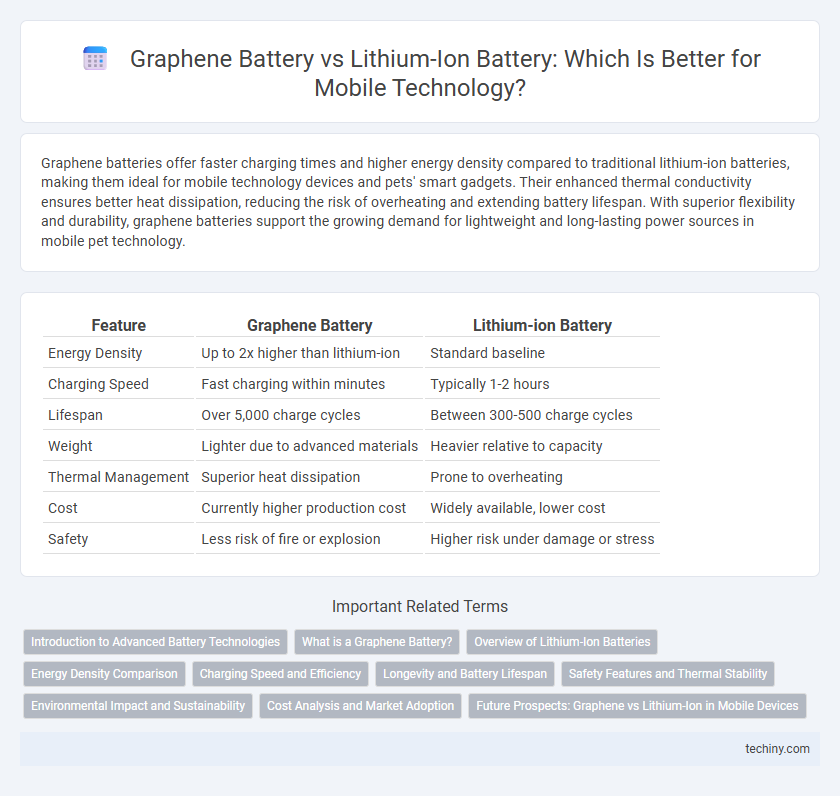Graphene batteries offer faster charging times and higher energy density compared to traditional lithium-ion batteries, making them ideal for mobile technology devices and pets' smart gadgets. Their enhanced thermal conductivity ensures better heat dissipation, reducing the risk of overheating and extending battery lifespan. With superior flexibility and durability, graphene batteries support the growing demand for lightweight and long-lasting power sources in mobile pet technology.
Table of Comparison
| Feature | Graphene Battery | Lithium-ion Battery |
|---|---|---|
| Energy Density | Up to 2x higher than lithium-ion | Standard baseline |
| Charging Speed | Fast charging within minutes | Typically 1-2 hours |
| Lifespan | Over 5,000 charge cycles | Between 300-500 charge cycles |
| Weight | Lighter due to advanced materials | Heavier relative to capacity |
| Thermal Management | Superior heat dissipation | Prone to overheating |
| Cost | Currently higher production cost | Widely available, lower cost |
| Safety | Less risk of fire or explosion | Higher risk under damage or stress |
Introduction to Advanced Battery Technologies
Graphene batteries offer higher energy density and faster charging capabilities compared to traditional lithium-ion batteries, making them a notable advancement in mobile technology. Their enhanced thermal conductivity improves battery lifespan and safety by reducing heat buildup during operation. As mobile devices demand longer usage and quicker recharge times, graphene battery technology presents a significant innovation in energy storage solutions.
What is a Graphene Battery?
A Graphene battery incorporates graphene, a single layer of carbon atoms arranged in a hexagonal lattice, to enhance energy storage and conductivity compared to traditional lithium-ion batteries. This advanced material allows for faster charging times, higher capacity, and improved thermal management, making it a promising option for next-generation mobile devices. Graphene batteries also exhibit greater durability and longer lifespans, addressing common limitations of lithium-ion technology in mobile technology applications.
Overview of Lithium-Ion Batteries
Lithium-ion batteries dominate the mobile technology market due to their high energy density, long cycle life, and rechargeability, making them suitable for smartphones, laptops, and electric vehicles. These batteries use lithium ions moving between the anode and cathode to store and release energy, offering a balance of power, weight, and cost-efficiency. Despite their widespread use, lithium-ion batteries face challenges such as thermal instability and limited lifespan under extreme conditions.
Energy Density Comparison
Graphene batteries offer significantly higher energy density compared to traditional lithium-ion batteries, enabling longer device usage and faster charging times. With energy densities potentially exceeding 1,000 Wh/kg, graphene technology surpasses lithium-ion's typical range of 150-250 Wh/kg, making it ideal for extended mobile device operation. This superior storage capacity also enhances the efficiency and lifespan of batteries in smartphones and other portable electronics.
Charging Speed and Efficiency
Graphene batteries offer significantly faster charging speeds compared to traditional lithium-ion batteries, often reducing charge times by up to 60%. Their enhanced electrical conductivity improves energy efficiency, allowing devices to maintain higher performance for longer periods without overheating. This efficiency also leads to greater battery longevity, making graphene technology a promising advancement in mobile device power solutions.
Longevity and Battery Lifespan
Graphene batteries offer significantly enhanced longevity compared to traditional lithium-ion batteries, providing up to 45% faster charging rates and retaining over 80% capacity after 3,000 cycles, whereas lithium-ion batteries typically last for about 500 to 1,000 cycles. The superior thermal conductivity of graphene reduces overheating, which directly contributes to extended battery lifespan and more consistent performance in mobile devices. This advancement supports longer usage periods and fewer battery replacements, optimizing the durability and reliability of smartphones and other portable electronics.
Safety Features and Thermal Stability
Graphene batteries exhibit superior safety features and thermal stability compared to traditional lithium-ion batteries, thanks to their enhanced heat dissipation properties and resistance to overheating. The graphene structure prevents thermal runaway, significantly reducing the risk of fires and explosions in mobile devices. This makes graphene batteries a safer alternative, especially in high-performance smartphones and electric vehicles requiring reliable and stable energy storage.
Environmental Impact and Sustainability
Graphene batteries exhibit a significantly lower environmental impact than traditional lithium-ion batteries due to their enhanced energy efficiency and longer lifecycle, which reduces the frequency of replacements and electronic waste. The use of graphene, derived from abundant carbon sources, supports sustainability by minimizing the extraction of rare and toxic metals commonly found in lithium-ion cells, such as cobalt and nickel. Furthermore, graphene batteries promote faster charging and cooler operation, decreasing energy consumption during use and contributing to overall greener mobile technology solutions.
Cost Analysis and Market Adoption
Graphene batteries offer faster charging speeds and longer lifespan compared to lithium-ion batteries but currently come with higher production costs due to complex manufacturing processes and limited raw material availability. Despite these costs, increased market adoption is expected as economies of scale improve and investment in graphene technology accelerates, driving prices down over time. Lithium-ion batteries maintain a dominant market share due to established supply chains and lower initial costs, though their environmental impact and performance limitations create opportunities for graphene battery integration.
Future Prospects: Graphene vs Lithium-Ion in Mobile Devices
Graphene batteries offer faster charging times, higher energy density, and increased durability compared to traditional lithium-ion batteries, positioning them as a transformative technology for mobile devices. Ongoing research aims to overcome production scalability and cost challenges, which could lead to widespread adoption in smartphones and wearable technology. As manufacturers seek longer battery life and enhanced safety, graphene's superior thermal conductivity and flexibility represent significant advantages for next-generation mobile power solutions.
Graphene battery vs lithium-ion battery Infographic

 techiny.com
techiny.com